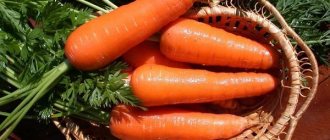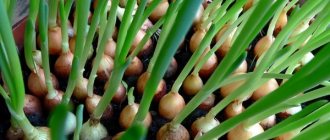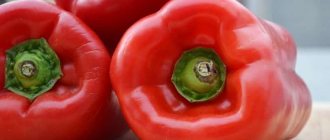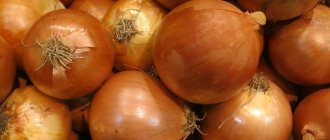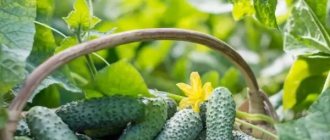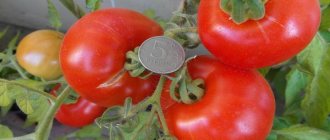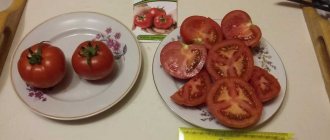Every season, breeders create dozens of new tomato varieties. Some of them look unusual. Some are distinguished by the exotic color of their fruits, others by their abundant flowering, and others by their decorative bushes. And every gardener who has been growing tomatoes for many years dreams of trying something original.
Scheherazade is considered one of the most unusual varieties of tomatoes. It is distinguished by ornamental bushes and fruits that resemble peaches. Is it difficult to grow such a tomato on your own plot and what are the features of its agricultural technology - read on.
General description of the variety
The Scheherazade tomato is a variety bred by domestic breeders. Its originators are Vladimir Dederko and Galina Botyaeva.
The tomato was registered in the Russian state register in 2007. This is a rare variety that is difficult to find in horticultural markets .
Features of Scheherazade
Scheherazade is an unusual variety that will decorate any area. It is distinguished by compact bushes with green-gray leaves.
The fruits of this tomato variety look exotic . They have pubescence that makes the berries look like peaches. Although Scheherazade tomatoes are red-orange in color, their light hairs make them appear pink.
The taste of tomatoes is rich , sweet, with barely noticeable sourness. There is a lot of pulp and it is tender. Rich tomato aroma.
Such tomatoes contain a large amount of lycopene and serotonin . These compounds enhance immunity, stimulate metabolism and remove free radicals, cholesterol, waste and toxins.
Scheherazade has increased immunity to tomato diseases. It is rarely affected by late blight, crown and root rot.
A negative feature of the variety is its instability to elevated temperatures. In the heat, it stops forming ovaries, and its fruits crack.
Main characteristics
Scheherazade attracts the attention of gardeners precisely because of the unusual appearance of its fruits and bushes . Other features of the tomato will not suit all gardeners.
Detailed characteristics and description of the Scheherazade tomato variety are given in the table:
| Parameter | Indicators |
| Bush type | Semi-determinate variety. Grows up to 1-1.5 m. Taller plants are grown in a greenhouse. The stems are powerful, with many leaves. Stepchildren are formed in large numbers. The leaves are long, drooping, emerald green with a bluish tint, covered with a dense layer of pubescence. Flowering is abundant. Few fruits are set. The berries are produced in clusters. Each of them bears 2-4 fruits. On average, 2-5 bunches are formed on one tomato. |
| Growing method | It can be grown in a greenhouse and in open ground in the southern and central regions. In cities with a northern climate, tomatoes of this variety are grown only in protected soil. |
| Productivity | Not tall. From one bush you get only 2 kg of fruit. From 1 sq. m receive no more than 6 kg of harvest. |
| Fruit | Medium size. The weight of one berry varies between 200-300 g. The color of tomatoes is red inside and outside. The skin is dense, abundantly pubescent. The shape of the berries is oblong, there is no pronounced ribbing at the base. The fruits are fleshy. The pulp is tender and juicy, but not watery. The taste is sweet with a pronounced tomato aroma and barely noticeable sourness. Inside each fruit there are 6-7 compartments with seeds. |
| Transportability | High. The skin protects tomatoes from damage when transported over long distances. These tomatoes can be stored for more than a month. |
| Ripening time | Mid-season tomato. The berries ripen 115-120 days after sowing the seeds. Fruiting continues until the first frost. |
| Disease resistance | Has high immunity to major tomato diseases. |
TOMATO PEEACHES! A FANTASTICALLY BEAUTIFUL VARIETY OF SCHEHERAZADE. Olga Chernova.
The following early varieties of tomatoes can be distinguished:
Evgenia. For open ground. For salads and canning. Drought resistant. Short dark green leaves. Red, dense, smooth tomatoes. Do not crack. Good taste. Gives good yields even in bad weather conditions.
Aurora F1. It is grown both for salads and for pickling. For open ground and for growing under film. Medium size sheets. Weakly ribbed fruits weighing up to 110g. Valued for its friendly fruiting.
Red sun F1. For open ground and for growing under film. Salad. Delicious slightly ribbed red tomatoes. Weight up to 120g.
A little prince. Gives a stable harvest. The taste is good. Smooth and round fruits.
Fat Jack. Red and sweet tomatoes, weighing up to 300g.
Admiral F1. It is grown both for salads and for pickling. Vigorous, indeterminate plant. Good taste, good fruiting. Resistant to many diseases. Weakly ribbed red tomatoes.
Hurricane F1. It is grown both for salads and for pickling. Medium branched plant. Low-leaved. Height up to 220cm. Medium sized leaves. Small flat-round fruits.
Spring drops. Ultra-ripe variety. Resistant to cold weather. Gives a stable, friendly harvest.
Frant F1. Salad. Medium-sized plant, indeterminate. Red, smooth, round, dense tomatoes. Fruit weight 150 g. Good taste. Resistant to diseases and adverse weather.
Tsarskoselsky. For open ground and for growing under film. Plants require staking and shaping. It is grown both for salads and for pickling. High-yielding. Red, smooth, flat-round tomatoes. Good taste. Easy variety.
Shady Lady. Smooth, dense red fruits suitable for salads. Excellent taste. Weight up to 200g. Heat-resistant plant, little affected by diseases.
Harmony. High-yielding variety, salad. Determinate, medium-leaved, medium-branched plant. Leaves are medium sized. The fruits are red and smooth. The taste is good. Plants are disease resistant. High marketability.
Admiralteysky. For open ground and for growing under film. It needs staking and plant formation. Red, dense and fleshy tomatoes. The taste is good. Productivity is high.
Growing seedlings
The Scheherazade tomato in our country can only be grown using seedlings . Seeds are sown 55-60 days before the plants are supposed to be planted in the ground. Seedlings begin to grow in March. Before sowing seeds, experienced gardeners advise checking the lunar calendar.
Seed treatment
Before sowing, the seeds must be prepared by treating them with a number of products . This increases their resistance to temperature changes and reduces the risk of plant infection:
- The seeds are soaked in a saline solution (1 teaspoon of salt per 1 liter of water). All floating specimens are thrown away, and those that have sunk to the bottom are used.
- Planting material is soaked in hydrogen peroxide or a light pink solution of potassium permanganate for half an hour. Then it is washed under running water.
- The seeds are treated with a growth stimulator. They are soaked according to the instructions in solutions such as Epin, Sodium Humate, etc.
This is interesting. Many gardeners prefer to germinate seeds before planting. To do this, planting material is wrapped in gauze moistened with a growth stimulator or water and placed in a warm place.
Selection of containers and soil
To grow seedlings, purchase universal soil or special soil for tomatoes . Prepare the soil mixture yourself. To do this, mix two parts of peat, one part of humus (compost), one part of earth, 0.5 parts of sand. The soil is taken from beds where nightshades (potatoes, peppers, tomatoes, eggplants) did not grow in the previous season.
About other unusual varieties of tomatoes:
Tomato “Mikado”, beloved by summer residents
Exotic taste and amazing view - “Irish Liquor”
Hybrid tomato "Ivan da Marya"
To reduce the acidity of peat, add 1 cup of ash or 3-4 tbsp to a bucket of the resulting substrate. l. dolomite flour. Urea (10 g), superphosphate (30-40 g) and potassium fertilizer (10-15 g) are also added to the mixture. Sometimes these components are replaced with a complex fertilizer containing nitrogen, potassium and phosphorus.
The soil must be disinfected . This is done in one of the following ways:
- pour over with a dark pink solution of potassium permanganate;
- pour boiling water over;
- baked in the oven.
For sowing, use pots, cups or boxes measuring 10x10 cm when sowing a small amount of seeds. If you plan to plant several beds of such tomatoes, then it is convenient to use special trays or boxes.
Scheherazade is a rare variety that is not easy to buy . Typically, gardeners plant only a few bushes of this tomato. In this case, it is more convenient to use peat tablets.
Containers are also disinfected. They are soaked for half an hour in a solution of potassium permanganate.
Sowing seeds
The substrate is poured into boxes, compacted and watered with a growth stimulator.
In each container, make two grooves 1 cm deep, into which the seeds are placed at a distance of 2 cm and sprinkled with soil. Then the containers are covered with transparent film or glass and placed in a warm place (24-25 ° C). Once a day, open the containers for 10-15 minutes to ventilate.
When the first shoots appear, the glass (film) is removed.
If seedlings are planted in peat tablets, the scheme will be different:
- The tablets are soaked in boiling water, placed in a deep container with the hole facing down;
- when all the water is absorbed, pour in a new portion of boiling water;
- after the workpieces swell and increase in size, they are taken out and turned over with the hole facing up;
- One seed is placed in each preparation, deepening it by 1 cm;
- The tablets are placed in one deep container and covered with film.
Seedling care
It is important to properly care for tomato seedlings . Then it will turn out strong and will easily take root after picking in a permanent place:
- Water the seedlings as the top layer of soil dries. It is important to ensure that the liquid does not fall on the above-ground part of the plants. The water should be warm.
- Seven days after the appearance of the first shoots, the ambient temperature is reduced: 16-18 °C during the day, 13-15 °C at night. This temperature regime is maintained for seven days. The plants are then brought into a room at room temperature. This will prevent the seedlings from pulling out prematurely.
- Tomato seedlings need 16 hours of daylight. In case of insufficient lighting, the seedlings are additionally illuminated with fluorescent or special phytolamps for seedlings.
- If the seeds were sown in a common box, then the tomatoes are planted in individual containers after two true leaves appear. Seeds planted in peat pots do not need picking.
- Before planting, seedlings are hardened off. To do this, the containers are taken out onto the open balcony for ten days. The air temperature should not be lower than 12 °C.
Tomato Your Majesty: description and characteristics of the variety, gardeners’ opinion with photos
Planting crops on the site is widespread. The Your Majesty tomato breaks records for yield among its own kind and amazes with its taste.
Basic ideas about the variety
For summer residents, detailed characteristics of the variety provide a lot of useful information. They help you choose the right place on the site or form a plant.
Bush:
- Indeterminate.
- Height up to 2 m.
- There are 3–5 tomatoes in one bunch.
- Ripens within 85–110 days.
Tomatoes:
- Large from 350–500 g, if conditions are favorable they reach 1 kg.
- The shape is flat-round or heart-shaped, various specimens are found.
- Yellow color.
- High density, fleshy. Large fruits are often without seeds.
Summer residents advise leaving 2-3 fruits for collecting seeds, because 1 may turn out to be empty.
- The skin is thin.
- They last up to 1 month.
A description of the main characteristics allows the gardener to understand whether such a variety is needed on his site or not.
Features of planting and care
The seedling method of cultivation is often used. Seeds are sown in advance; each vegetable grower calculates the timing independently, depending on the weather conditions of the region. The age of seedlings transplanted to a permanent place should be 60 days.
Techniques for growing seedlings:
- Lighting and temperature. For normal growth of seedlings, light is required at least 14 hours a day. Air temperature 20–22 ⁰С.
- Watering. Drying or waterlogging of the soil is not allowed.
- Feeding. To form a powerful stem and root system, complex fertilizers are used to stimulate growth.
- Dive at phase 2 of the true leaf.
- The seedlings are hardened off 1–2 weeks before transferring to the soil. Take it out into the open air. First for 15–20 minutes, then increase to 8–10 hours.
Place 3 plants per 1m2 on the beds. Summer residents recommend forming a bush with 2–3 stems; the growth point is removed when the bush is 1–1.5 m in height. Water as needed. The water used is warm.
Mulching and loosening the beds will help retain moisture in the soil longer. Removing weeds will help avoid the development of diseases and attacks by insect pests.
Plant immunity
Susceptible to many diseases. You should not define a tomato variety as unsuitable for cultivation. If preventive treatment is carried out in time, the plant will reward you with a high yield. Regular watering, weeding and other agricultural practices will help avoid the spread of diseases.
Use in home cooking, yield volume
The variety Your Majesty is used for any type of winter preparations. They are not suitable only for whole canning. Summer residents recommend making juice, dressing or salads from it. The unusual color of tomatoes makes them indispensable in preparing assorted vegetables. When fresh, it performs well in salads and as a table decoration.
If you follow the requirements and planting rules, 1 plant will yield 2–3 kg of tomatoes. Productivity is increased by proper formation of the bush and tying plants to supports.
Positive and negative characteristics of the species
Tomatoes have positive and negative sides. Each summer resident reasons differently, so for some the presence of one sign is good, but for another it is bad.
Pros:
- Stable high yield.
- Unusual taste.
- Versatility when using tomatoes.
- The bushes bear fruit for a long time.
Minuses:
- Susceptible to diseases.
- Requires formation.
- The tomatoes are cracking.
What do summer residents say about tomatoes, Your Majesty?
Reviews about the variety are different; every summer resident has the right to his own opinion. You need to plant the plant yourself to understand what it really is. And specific recommendations are found in x vegetable growers.
- Yulia: “It is especially difficult to grow, since it requires a garter, but it’s worth it. The taste is excellent, the preparations are very beautiful.”
- Anatoly: “I’ve been planting this variety for 5 years. During this time I have never been disappointed. Delicious and unpretentious tomatoes.”
Fans of large-fruited tomatoes will appreciate Your Majesty for its unusual taste.
Agricultural technology of Scheherazade
Scheherazade is planted in open ground when the threat of return frosts has passed . The soil at a depth of 15 cm by this time should not be colder than 12 °C.
Before planting in a permanent place, the seedlings are watered and fed. Fertilizers with phosphorus are used for better formation of the root system.
Picking tomatoes to a permanent place
For Scheherazade tomatoes, choose a semi-shaded area of the garden . This variety does not tolerate extreme heat.
In the fall, the beds are dug up. They are cleared of weeds and crop residues. Rotted manure is added to the soil at a rate of 4 kg per 1 sq. m . If the acidity of the soil is increased, it is reduced with the help of wood ash. In spring, the beds are leveled with a rake. They are watered with mullein solution and copper sulfate.
Holes are dug in rows. For 1 sq. m plant 3 plants when forming into 1 stem , and 4 when forming into 2 trunks.
Wood ash is added to the holes prepared for planting. The depth of the hole depends on the height of the seedlings. They are advised to be placed in the ground up to the level of the first leaves.
Features of agricultural technology in open and protected ground
It is not recommended to grow tomatoes for several years in a row in the same place , or on land where nightshade crops previously grew. In the greenhouse where tomatoes were already grown last season, the soil is changed. To prevent diseases, the ground is sprayed with a hot solution of copper sulfate (1 tbsp per bucket of water).
The beds in the greenhouse are prepared a week before planting the seedlings . The recommended height of the beds is 25-30 cm, width – 60-90 cm. The passage between them is 60-70 cm. Plants need to be provided with loosening, good drainage and moderate humidity.
In greenhouses, Scheherazade tomatoes are planted in warmed soil , the temperature of which should be at least 13 ° C at a depth of 20 cm. Plants are placed in rows or in a checkerboard pattern at a distance of 50-60 cm.
Advice. Before planting in a greenhouse or open ground, the holes should be watered with a weak solution of potassium permanganate (1 g per 10 liters of water), to which complex fertilizer has been added.
Planting and care
Seeds are sown for seedlings in March or April in well-fertilized and light soil. It is made from ordinary soil with peat, river sand and ash are added. The seed material is soaked for 2-3 hours in a solution of potassium permanganate, and then for half a day in a homemade stimulant made from soda or honey with water.
Sow to a depth of 1 cm. The room temperature should be 24-25 degrees, and within a week after germination - 18. When the seedlings grow two leaves, they are pricked.
The bushes are not placed very densely in the garden bed to ensure ventilation. Water regularly, but moderately, with warm water. Fertilize periodically.
Farmer reviews
Reviews from gardeners about Scheherazade are contradictory . Almost everyone likes unusual fruits, but many are not satisfied with the low yield of this variety.
Zinaida, Tver : “Very good variety! Funny fluffies have grown up, just like in the photo! Not very productive, but there were no problems with sores. It led into two stems.”
Maria, Voronezh : “It looks original, but the harvest was disappointing. There are much more productive varieties that ripen faster. I definitely won’t plant next year.”
Anton, Rostov : “The tomatoes are delicious and look unusual. Guests came to the dacha and were very surprised. In the greenhouse it bears fruit longer than other varieties.”
Advantages and disadvantages
As the characteristics of the variety and numerous positive reviews from summer residents show, the variety has more positive properties than negative ones.
Pros:
- stable, high yield;
- simultaneous maturation;
- high density;
- versatility in use;
- tomatoes do not crack;
- excellent taste characteristics;
- immunity to certain diseases;
- undemanding and unpretentiousness;
- fruits last a long time and can be transported over long distances;
- the best variety for canning, salting and pickling.
Minuses:
- very rough skin;
- it is necessary to secure the brushes;
- seed material collected from Caspar f1 does not retain the parental genes.
The negative characteristics are insignificant compared to the number of advantages this hybrid has.

